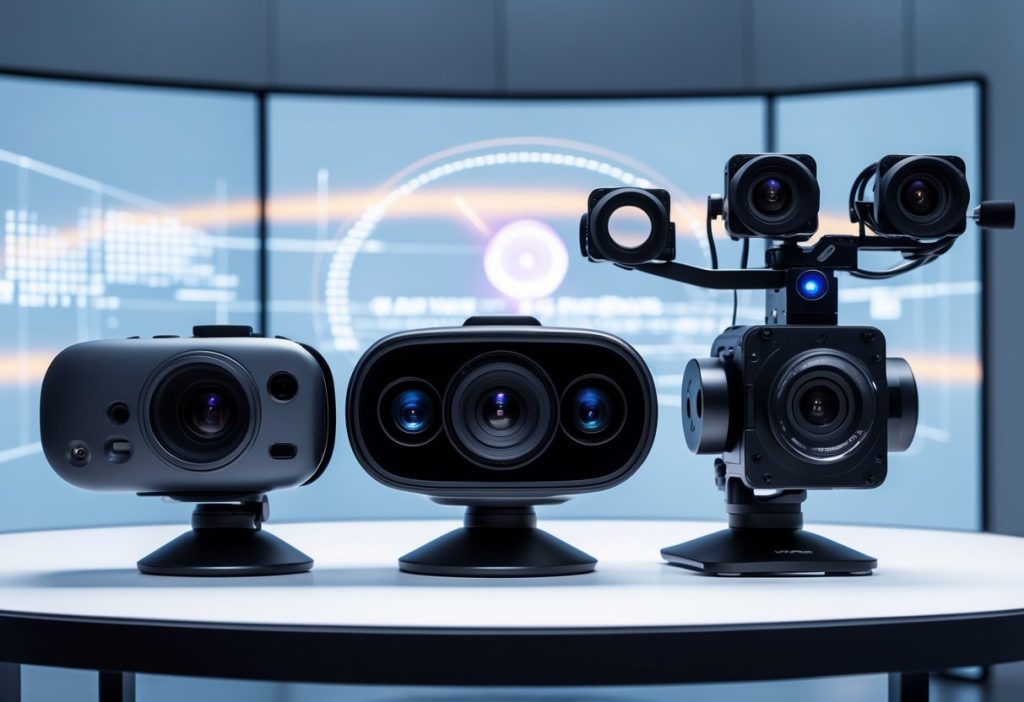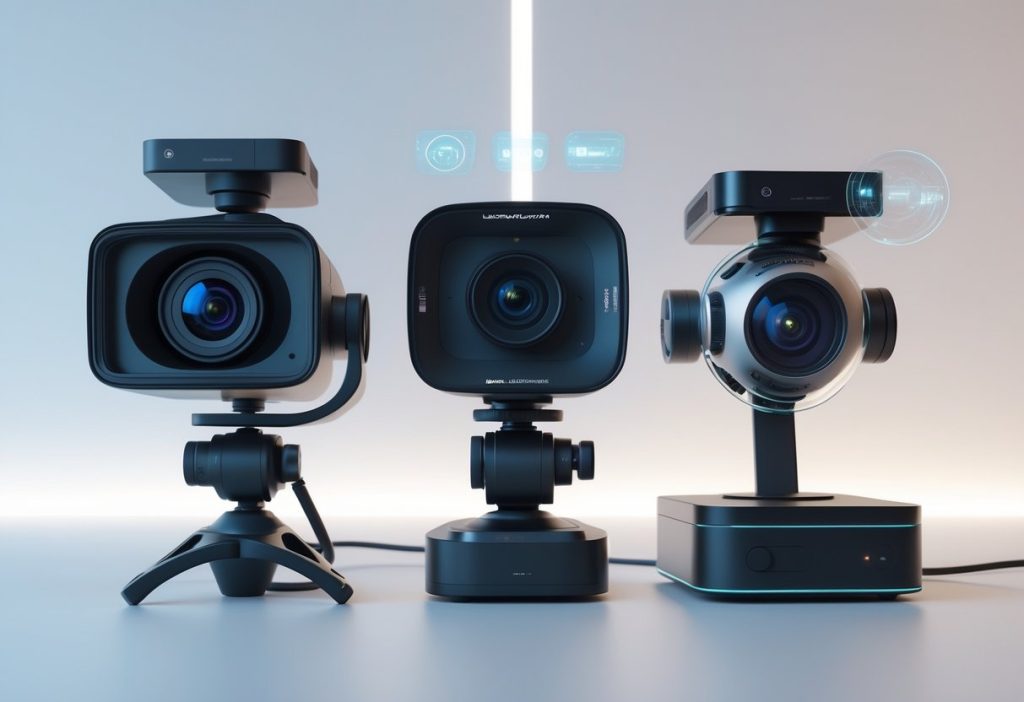Defining 180°, 360°, and 6DoF VR Camera Technologies

Let’s be honest, the way virtual reality content has changed is wild, especially when you look at the role VR cameras have played. These days, you’ve got 180°, 360°, and even 6DoF capture options, each with its own quirks that totally shift how real and immersive everything feels.
Ever wondered what the real difference is between a 180° camera and a 360° one? It’s not just about numbers, it’s about how you engage with the scene.
Core Differences Between 180° and 360° VR Cameras
A 180° VR camera focuses on what’s in front of you, kind of like looking through a window. You get crisp detail and a close-up vibe since all those pixels are packed into half a sphere.
Switch to a 360° setup, and suddenly you’re surrounded. You can peek behind you, look up, spin around, though sometimes that means the image isn’t quite as sharp unless you’re working with massive resolutions. Here’s a quick breakdown:
| Feature | 180° VR | 360° VR
|
|---|---|---|
| Field of View | Front-facing (hemisphere) | Full sphere |
| Immersion | Focused and intimate | Surrounding and exploratory |
| Resolution Efficiency | High pixel density | Lower per-area pixel density |
| Production Complexity | Lower | Higher due to stitching multiple lenses |
Both approaches have their place in VR tech.
Some folks love the intimacy and clarity of 180°, while others crave the “I’m in the middle of it” feel that 360° brings.
What 6DoF Brings to Virtual Reality Experiences
Here’s where things get wild: 6DoF, or six degrees of freedom, lets you move through a scene, forward, back, up, down, side-to-side, and rotate your head. No more just spinning in your chair.
In adult VR, this means you can lean in, shift your view, and experience a sense of presence that’s pretty hard to describe until you try it. It’s almost eerie how real it feels.
But achieving this isn’t easy. You need accurate depth mapping, careful calibration, and sometimes a spiderweb of synchronized cameras. When it works, though, it’s a whole new level of interaction.
Key Technical Specifications for VR Content
If you want buttery-smooth, realistic VR video, there’s no getting around the tech details. Resolution matters, a lot. Most 180° and 360° content runs at 4K or 8K per eye, and you’ll notice the difference when you put on a headset.
Frame rates of 60 fps or better help keep things feeling natural, especially when you whip your head around. For 6DoF, it’s all about depth accuracy. Stereo camera rigs, LiDAR, and some pretty wild algorithms come into play to make sure the scene moves with you.
Compression and playback optimization are huge, too. There’s nothing worse than choppy video when you’re trying to get lost in a virtual world.
Milestones in VR Camera Evolution for Adult Entertainment

It’s kind of fascinating how much VR camera tech has changed adult entertainment. Every leap forward has made things more real, more interactive, and honestly, more fun for both viewers and creators.
Early Adoption of 180° and 360° Cameras
Back when VR first started heating up in adult content, 180° and 360° rigs were the go-to. Viewers could finally look around, not just stare straight ahead like in old-school video.
Studios loved dual-lens 180° gear for that up-close, personal feel. Meanwhile, 360° rigs with multiple lenses let you see the whole room, sometimes at the cost of a little sharpness.
The tech wasn’t perfect. Frame rates lagged, stitching was rough, and the gear was anything but discreet. Still, it was a game-changer for immersive storytelling.
Breakthroughs in Camera Rigs and Recording Techniques
As time went on, people demanded better quality and smoother action. Camera arrays got smaller, smarter, and way more stable. Suddenly, capturing depth and perspective felt less like a science experiment and more like movie-making.
Stabilized mounts, smarter stitching, and sensors that could handle weird lighting boosted production value. Studios started building their own rigs to get the perfect shot and angle, which made scenes feel a lot more natural.
All of this meant sharper, more lifelike footage and way fewer headaches for directors. It also let performers move around more comfortably, which, let’s face it, makes a difference.
Transition to Interactive and Volumetric Capture
Now we’re seeing a shift from just “watching” to actually “being there.” Volumetric capture and six degrees of freedom recording let you move within the space, not just look around.
This isn’t just about eye candy. With real-time rendering, you can get personalized viewpoints, follow interactive storylines, and even see AI characters react to you. It’s a whole new world for creators, and for fans.
Of course, volumetric filming is tough. You need pro lighting, advanced motion tracking, and some serious post-production muscle. But the payoff? It’s the closest thing yet to true virtual intimacy.
How Camera Formats Shape Immersion in Adult VR
Let’s talk about the user side for a second. The camera format decides how “real” and immersive things feel. Field of view, motion freedom, and depth capture all play a part in whether you actually forget you’re wearing a headset.
Field of View’s Role in Viewer Engagement
Field of view, FOV for short, basically means how much you can see at once. A 180° video keeps you focused on what’s in front, while 360° puts you smack in the center of the action.
For adult content, 180° is easier to shoot and keeps the crew out of sight. It’s all about focus, but you might feel a bit boxed in sometimes.
With 360° capture, you get freedom to look wherever you want. It’s closer to real life, but directors can’t always control where you’re looking, which can be both good and bad.
Realism and Presence in 6DoF Scenes
Moving from three degrees of freedom (just turning your head) to full 6DoF is a game-changer. Now, when you lean or crouch, the scene shifts with you. It’s the difference between peering through a window and stepping into the room.
This is what gives you that “I’m actually here” feeling. Your brain buys into the illusion because the depth and parallax cues are finally right.
For adult VR, this means you can find your own angle, literally. But let’s not kid ourselves: making this work takes complicated rigs and a lot of post-production magic.
Limitations of Traditional VR Video
Old-school 2D or 3D-360 video relies on stitching together footage from a bunch of fisheye lenses. You can look around, but you’re still stuck in place, no leaning in, no shifting your view.
3D-360 helps a bit with depth, but it can’t fully trick your senses. Try to move, and you’ll hit that invisible wall. It’s a reminder that true immersion needs both visual sharpness and real movement.
New systems aim to close that gap, blending high-res video with spatial tracking. We’re not quite there yet, but the progress is hard to ignore.
Personalization and AI in VR Adult Content
AI is shaking things up in ways that go beyond just camera tech. Now, virtual experiences can adapt to your preferences in real time, tweaking everything from pacing to the way characters interact with you.
It’s not perfect, but it’s getting there. The days of generic, one-size-fits-all scenes are fading as AI and smarter VR cameras make digital encounters feel more personal, and honestly, more human.
AI-Driven Scene Customization for VR Cameras
AI is now a driving force in content creation for VR Cameras and adult media. Instead of sticking to preset scenes, smart algorithms can tweak environments, lighting, and even what characters do, based on what viewers want.
That means you’re not just watching; you’re shaping the experience as it happens. No two sessions have to feel the same.
Machine learning models interpret gestures, gaze, and voice commands, adding a layer of mutual interaction. If you look or speak, the virtual performer might react in real time, pretty wild, right?
Developers are training systems to pick up on emotional tone or how engaged you seem. That way, dialogue and camera angles can subtly shift to fit the mood.
Here’s a quick breakdown of how AI stacks up against traditional setups:
| Feature | Traditional VR | AI-Enhanced VR
|
|---|---|---|
| Scene Setup | Fixed | Dynamic |
| Performer Response | Pre-recorded | Adaptive |
| User Control | Limited | Real-time |
Adaptive Content Based on Viewer Preferences
Personalization isn’t just about what you see, it’s about how you see it. AI-driven platforms track stuff like your favorite camera distance, pacing, or even which performer style you go for.
Let’s say you like slower scenes or a certain mood. The system can adjust lighting, sound, or timing to match, almost like it’s reading your mind.
It’s not just for viewers, either. Creators get to see aggregated analytics and spot what’s trending, which helps them fine-tune their strategies for VR Cameras and related gear.
According to a recent survey from VR Intelligence, 62% of adult content creators now use AI analytics to inform scene direction and pacing. That’s a huge jump from just 27% three years ago.
Live Streaming and Real-Time Interactivity with VR Cameras
Live streaming has totally changed how we interact with VR Cameras and adult content. You’re not just a passive watcher anymore; you can actually engage with performers in real time.
Streaming quality and camera tech have made massive leaps, making these experiences way more immersive and personal.
VR Webcam Shows and Performer-Audience Engagement
With VR webcam shows, it feels like you’re sharing the same space as the performer. You can look around, choose your perspective, and feel present in the room, way beyond just watching on a flat screen.
Creators use VR180 or 360° setups, letting viewers pick their viewpoint. Some platforms toss in gesture tracking, voice chat, or tipping, so you’re not just along for the ride, you’re steering, at least a little.
Real-time analytics let performers adjust on the fly, tweaking things like camera angles or lighting. This keeps the whole thing fresh and interactive, and honestly, it seems to build real loyalty among fans.
Tech Upgrades in Streaming Quality for VR Cameras
Tech advances have kicked VR live streaming up several notches. Cameras like the Kandao VR Cam now handle 8K 3D output with low latency and H.265 encoding, so you get insane resolution without killing your bandwidth.
Modern streaming protocols, think RTMP, SRT, and RTMPS, keep things stable, even if your internet’s not perfect. Buffering is less of a headache, and audio-video sync is tight.
We’re seeing better color accuracy, depth rendering, and pixel sync between both eyes. All this makes broadcasts smoother and more lifelike, keeping you pulled into the action.
Integrating Haptic Feedback and Sensory Technologies with VR Cameras
The real magic happens when visual immersion from VR Cameras is paired with tactile and sensory feedback. Haptic systems and other cues mean you can see, hear, and even feel what’s happening in the virtual world.
That’s not just a gimmick, it adds a whole new layer of realism and responsiveness.
Enhancing Immersion with Haptic Devices for VR Cameras
Haptic feedback brings touch into the mix, so you might feel pressure, vibration, or movement that matches what you’re seeing and hearing. In adult VR, this can sync up physical sensations with everything else, making the experience more believable.
Wearables come in all shapes: gloves, bodysuits, controllers. Each one focuses on a different kind of feedback. For example:
| Device Type | Primary Feedback | Common Use
|
|---|---|---|
| Gloves | Texture, pressure | Hand-based interaction |
| Bodysuits | Full-body vibration | Immersive role-play |
| Controllers | Motion and vibration | Interactive touch points |
Intensity, timing, and location of feedback can all be customized to fit what’s happening in the scene. When the physical and visual cues line up, you really start to feel like you’re there.
Future of Multi-Sensory VR Cameras Experiences
Next-gen VR Cameras will go beyond sight and touch, think temperature, scent, even airflow. Multi-sensory systems could simulate warmth or subtle vibrations that match what’s happening around you virtually.
Researchers are working on lighter, faster-responding devices to make these sensations more realistic. Pairing haptic pressure with directional audio, for example, can trick your brain into thinking it’s real contact.
As VR Cameras evolve toward 6DoF (six degrees of freedom), users will be able to move around more naturally. Haptic systems will need to keep up, adapting instantly to every move for a seamless experience.
AR and Augmented Reality in Adult Entertainment with VR Cameras
Augmented reality (AR) adds interactive digital elements to the real world, blending physical and digital spaces in ways VR Cameras alone can’t. It’s a fresh way to personalize and experience adult content.
AR’s potential is just starting to be tapped, but it’s already making waves.
Blending AR and VR Cameras for Hybrid Experiences
Combining AR with VR Cameras leads to hybrid setups that mix your real-world surroundings with immersive digital environments. It’s a way to bridge passive viewing and total immersion.
Picture this: AR glasses project virtual performers right into your living room. You can move and interact, but you’re still aware of what’s around you.
Developers use spatial mapping and depth sensing to make these overlays look natural and responsive. It’s not perfect yet, but it’s getting closer all the time.
| Technology | Function | Result
|
|---|---|---|
| AR overlays | Adds digital visuals to real-world view | Blends real and virtual space |
| VR immersion | Creates a full digital environment | Enhances depth and realism |
| 6DoF tracking | Tracks motion and position | Enables natural movement |
This hybrid approach with VR Cameras opens up new creative possibilities and gives users more control over their experiences.
Emerging AR Applications for VR Cameras in Adult Content
AR in adult entertainment is about more than just visuals, it’s about personalization, interactivity, and making things more accessible. Users can project 3D avatars or interactive scenarios into their space using phones or AR headsets.
Some platforms already use face and body tracking, so you can adjust angles or gestures in real time. It’s a more participatory experience, not just watching from the sidelines.
There’s also a practical side: AR gets used for education, like anatomy tutorials or intimacy guides, shown as realistic overlays. It’s not all about novelty, sometimes it’s genuinely useful.
As AR gear gets smaller and more affordable, expect to see it pop up even more in adult content. The blend of real and digital spaces is just too good to ignore.
Challenges and Opportunities for VR Cameras Content Creators
Let’s be real, working with VR Cameras in adult entertainment isn’t always smooth sailing. High production costs, privacy worries, and fast-moving tech present some headaches, but there’s also a ton of room for new ideas and audience connection.
Production Costs and Technical Barriers for VR Cameras
Making immersive VR content means investing in specialized cameras, editing software, and a lot of storage. 360° and 6DoF setups need multiple lenses and advanced stitching, which isn’t cheap or easy to run.
Rendering and editing can eat up terabytes of data, pushing hardware and archiving costs through the roof. Even short clips add up fast.
Motion sync and viewer comfort are big deals, too. Mess up calibration, and you risk motion sickness for your audience. Getting lighting, audio, and camera placement right is crucial for realism.
On the bright side, AI-assisted editing and real-time rendering are starting to lower the bar. As these tools get better, expect more creators, big and small, to join in and push the boundaries of what VR Cameras can do.
Balancing Privacy and Innovation with VR Cameras
Privacy is a huge concern in adult VR Cameras content creation. Both performers and viewers face risks related to identity exposure and data tracking
High-resolution imaging and biometric data from headsets might accidentally reveal personal details. Sometimes, it feels like every new leap in VR Cameras tech comes with a new privacy headache.
Secure data handling and clear consent protocols are absolutely essential. Encryption, anonymized metadata, and keeping distribution channels limited can help protect everyone involved.
But let’s be honest, innovation doesn’t slow down. Interactive, personalized experiences in VR Cameras rely on user data to adapt scenes in real time.
This creates a real tension between personalization and privacy. There’s no easy answer, but it’s something the industry can’t ignore.
Transparent policies and giving performers control over their digital likeness matter a lot. Ethical use of emerging tools is key to keeping things safe without killing creativity.
